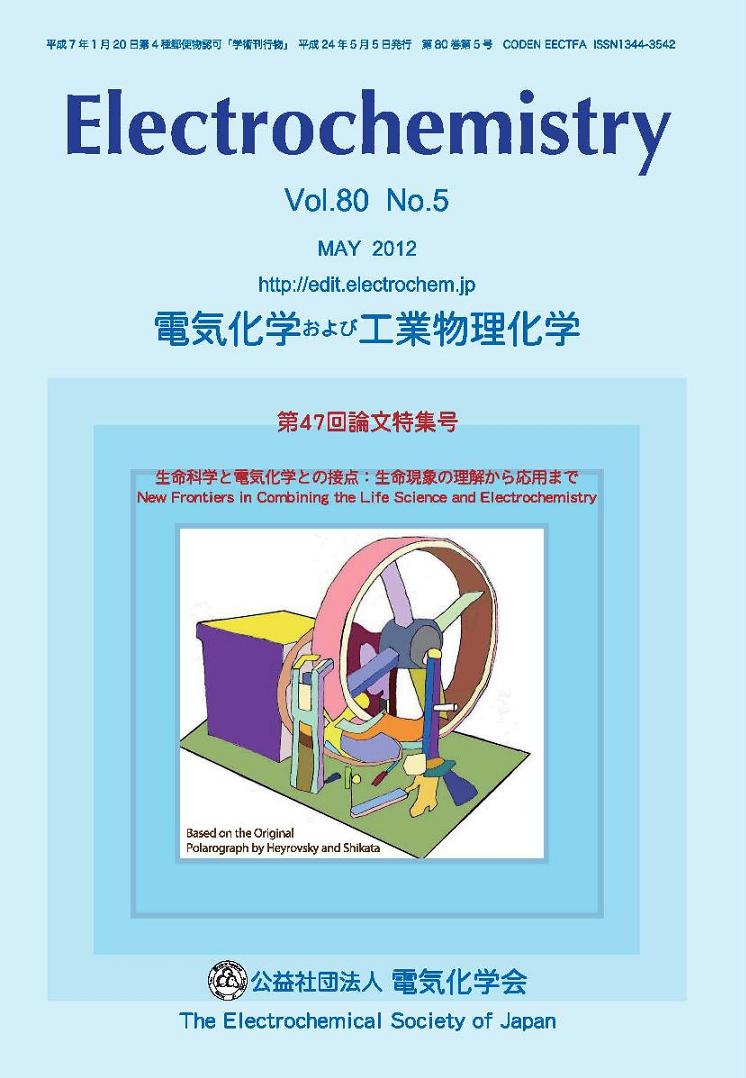80 巻, 5 号
選択された号の論文の27件中1~27を表示しています
- |<
- <
- 1
- >
- >|
生命科学と電気化学との接点:生命現象の理解から応用まで
展望
-
2012 年 80 巻 5 号 p. 291
発行日: 2012/05/05
公開日: 2012/05/05
PDF形式でダウンロード (263K) -
2012 年 80 巻 5 号 p. 292
発行日: 2012/05/05
公開日: 2012/05/05
PDF形式でダウンロード (207K)
Headline
-
2012 年 80 巻 5 号 p. 293-298
発行日: 2012/05/05
公開日: 2012/05/05
PDF形式でダウンロード (1397K)
コミュニケーション
-
2012 年 80 巻 5 号 p. 299-301
発行日: 2012/05/05
公開日: 2012/05/05
PDF形式でダウンロード (980K) -
2012 年 80 巻 5 号 p. 302-304
発行日: 2012/05/05
公開日: 2012/05/05
PDF形式でダウンロード (765K) -
2012 年 80 巻 5 号 p. 305-307
発行日: 2012/05/05
公開日: 2012/05/05
PDF形式でダウンロード (865K) -
2012 年 80 巻 5 号 p. 308-311
発行日: 2012/05/05
公開日: 2012/05/05
PDF形式でダウンロード (2134K) -
2012 年 80 巻 5 号 p. 312-314
発行日: 2012/05/05
公開日: 2012/05/05
PDF形式でダウンロード (625K) -
2012 年 80 巻 5 号 p. 315-317
発行日: 2012/05/05
公開日: 2012/05/05
PDF形式でダウンロード (399K) -
2012 年 80 巻 5 号 p. 318-320
発行日: 2012/05/05
公開日: 2012/05/05
PDF形式でダウンロード (1274K) -
2012 年 80 巻 5 号 p. 321-323
発行日: 2012/05/05
公開日: 2012/05/05
PDF形式でダウンロード (688K) -
2012 年 80 巻 5 号 p. 324-326
発行日: 2012/05/05
公開日: 2012/05/05
PDF形式でダウンロード (528K) -
2012 年 80 巻 5 号 p. 327-329
発行日: 2012/05/05
公開日: 2012/05/05
PDF形式でダウンロード (400K) -
2012 年 80 巻 5 号 p. 330-333
発行日: 2012/05/05
公開日: 2012/05/05
PDF形式でダウンロード (681K) -
2012 年 80 巻 5 号 p. 334-336
発行日: 2012/05/05
公開日: 2012/05/05
PDF形式でダウンロード (348K)
報文
-
2012 年 80 巻 5 号 p. 337-339
発行日: 2012/05/05
公開日: 2012/05/05
PDF形式でダウンロード (134K) -
Determination of Ammonia in Exhaled Breath by Flow Injection Analysis with Electrochemical Detection2012 年 80 巻 5 号 p. 340-344
発行日: 2012/05/05
公開日: 2012/05/05
PDF形式でダウンロード (580K) -
2012 年 80 巻 5 号 p. 345-347
発行日: 2012/05/05
公開日: 2012/05/05
PDF形式でダウンロード (281K) -
2012 年 80 巻 5 号 p. 348-352
発行日: 2012/05/05
公開日: 2012/05/05
PDF形式でダウンロード (1059K) -
2012 年 80 巻 5 号 p. 353-357
発行日: 2012/05/05
公開日: 2012/05/05
PDF形式でダウンロード (678K) -
2012 年 80 巻 5 号 p. 358-362
発行日: 2012/05/05
公開日: 2012/05/05
PDF形式でダウンロード (1679K) -
2012 年 80 巻 5 号 p. 363-366
発行日: 2012/05/05
公開日: 2012/05/05
PDF形式でダウンロード (1550K) -
2012 年 80 巻 5 号 p. 367-370
発行日: 2012/05/05
公開日: 2012/05/05
PDF形式でダウンロード (659K) -
Nitrous Oxide Sensing using Oxygen-Insensitive Direct-Electron-Transfer-Type Nitrous Oxide Reductase2012 年 80 巻 5 号 p. 371-374
発行日: 2012/05/05
公開日: 2012/05/05
PDF形式でダウンロード (610K)
技術報文
-
2012 年 80 巻 5 号 p. 375-378
発行日: 2012/05/05
公開日: 2012/05/05
PDF形式でダウンロード (659K)
-
2012 年 80 巻 5 号 p. 379-386
発行日: 2012/05/05
公開日: 2012/05/05
PDF形式でダウンロード (843K) -
2012 年 80 巻 5 号 p. 388
発行日: 2012/05/05
公開日: 2023/12/27
PDF形式でダウンロード (387K)
- |<
- <
- 1
- >
- >|
